Independence National Historic Park, Philadelphia
Although I’m a Canadian and a resident of Nova Scotia, the 14th colony that chose to side with Britain, I have always been an admirer of the people and principles that led to the creation of the United States, particularly the Constitution. For many years I have wanted to visit Philadelphia and tour the sites where the Declaration of Independence was signed, the constitution drafted and George Washington inaugurated. And of course, there’s the famous Liberty Bell with its crack. You can do all these things in a small area of historic Philadelphia by visiting Independence National Historic Park which Alison and I did on a recent two day stay in the area. Here’s why we were greatly impressed with what we saw.
We stayed in the excellent Morris House Hotel which is in two historic buildings within a few blocks of Independence National Historic Park. It was a blustery, but bright early April day and our first stop was in Washington Square which is actually part of Independence National Historic Park. The reason becomes apparent when you read the inscription on this monument; thousands of unknown soldiers lie buried under your feet, the first such unknown soldiers in the long history of American conflict.
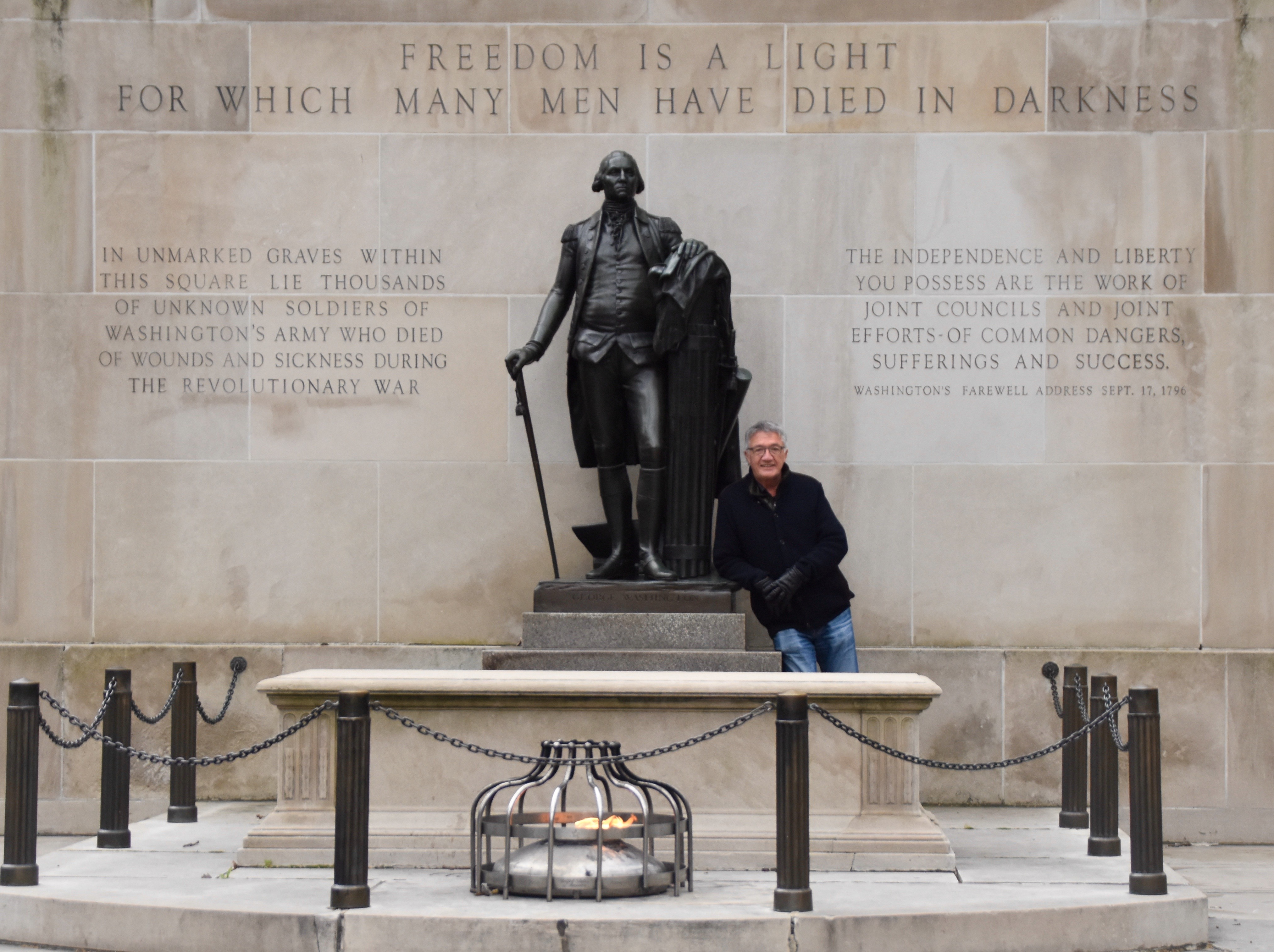
I never pass up a chance to get my picture taken with George Washington as I think he was and will always be the greatest of American Presidents, a man who rose to meet a challenge not of his own making and in retrospect, succeeded beyond anyone’s expectations. Not only did Washington win the war, but more importantly by voluntarily giving up the Presidency, he established the precedent of a transfer of powers based on the votes of the people and not the force of arms.
Another interesting fact about Washington Square is that it was the site of the first balloon flight in the U.S. in 1793.
Independence National Historic Park Visitor Center
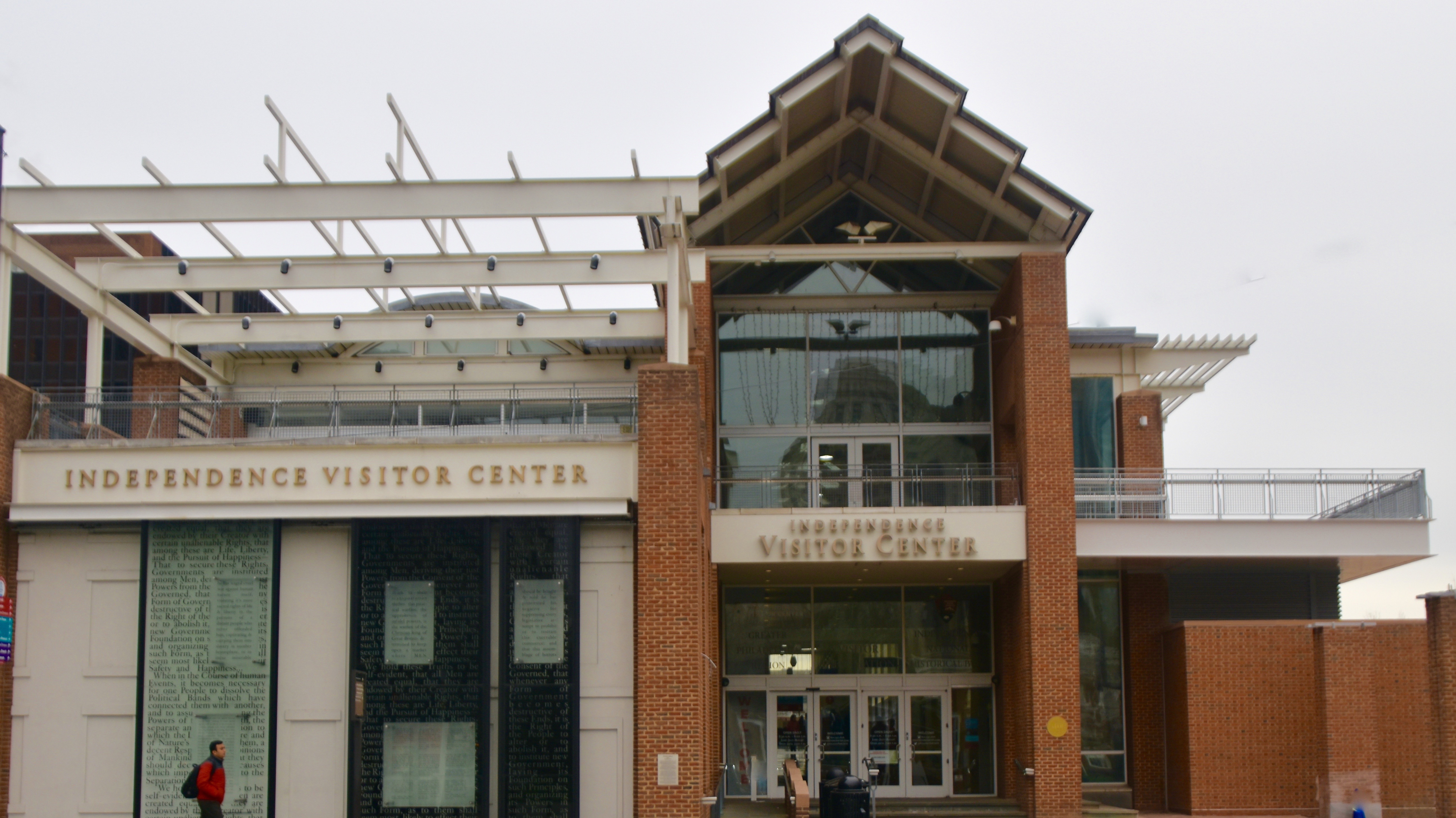
Every visit to Independence National Historic Park needs to formally start at the Independence Visitor Center. This is because you can only tour Independence Hall and Congress Hall, the two most important sites in the park, on a guided tour and for that you need to get your free tickets here. The number of visitors per day is limited, so given the potential long lines in the busier times of year, I suggest getting here at least fifteen minutes before the opening time. In April the opening time was 8:30 and we got here at 8:15 and there were still at least twenty people ahead of us.
A much better idea is to reserve your tickets in advance by following this link to the NPS web site and doing it on line. That way you avoid a potential long wait in line or even the disappointment of not getting a ticket at all. If you do have reserve tickets they still need to be picked up at the Visitor Center, which is worth visiting in its own right. The theatres that are usually in operation at the center where being renovated during our visit, but should be reopened for the summer season. Still you can get your picture taken with Ben Franklin, Rocky Balboa, the Philly Fanatic or just let people know that you are in Philadelphia. It’s also the place to buy your Independence National Historic Park souvenirs.

Independence Hall, Independence National Historic Park
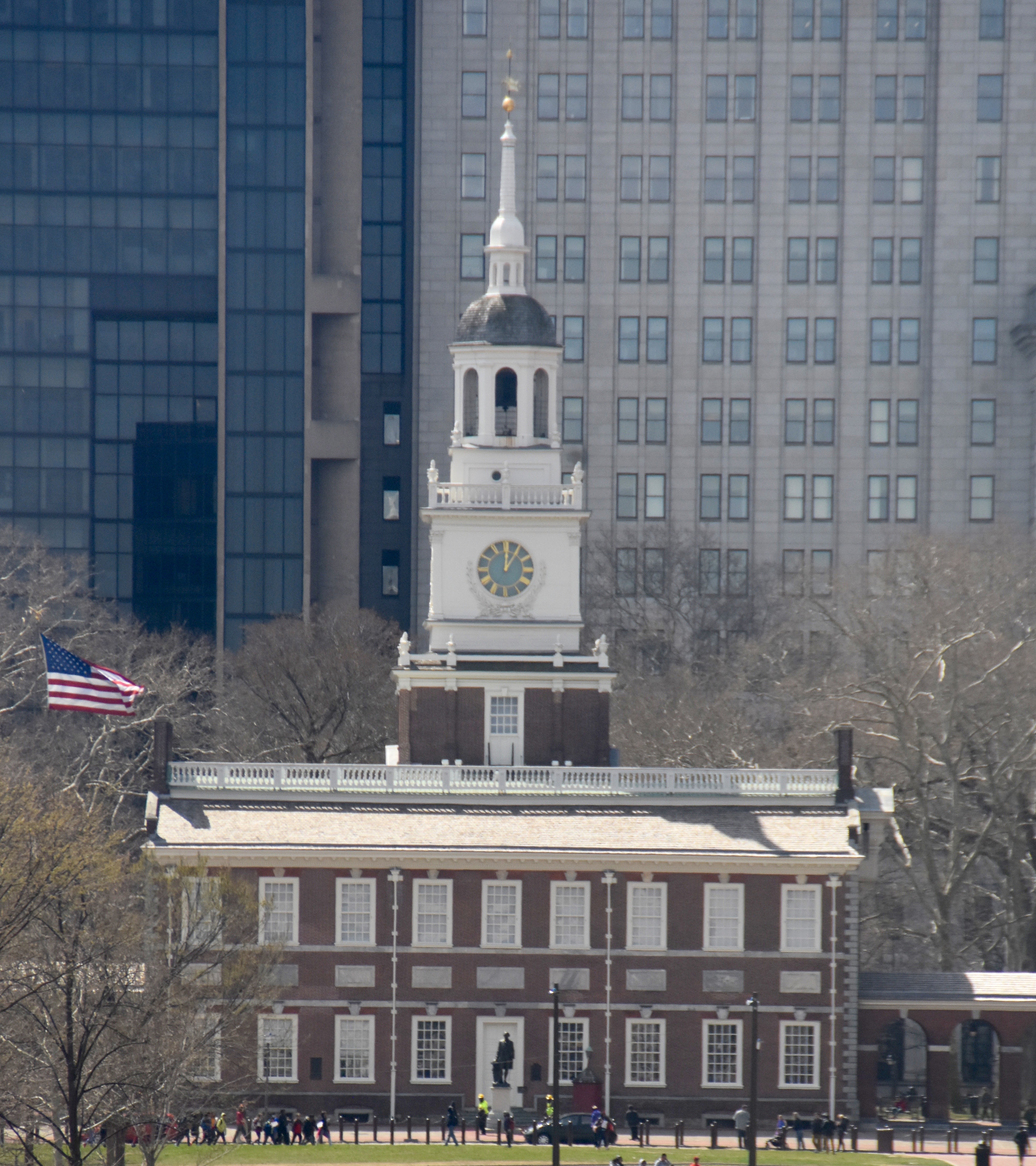
This is the view of Independence Hall that you get across the street from the Visitor Center in the large green quad that separates the two buildings. I was a bit expecting that I would be disappointed in seeing how small the building actually was, because, as you can see, it is dwarfed by modern high rise commercial buildings behind it. Instead, there was no ‘Alamo effect’ and Independence Hall would be an impressive building from an architectural standpoint even if nothing important had never happened inside it. However, it is a UNESCO World Heritage Site precisely because of what happened inside in 1776 and 1787. Here is the UNESCO description of why Independence Hall is worthy of its status as a World Heritage Site:
The Declaration of Independence was adopted and the Constitution of the United States of America framed in this fine early 18th-century building in Philadelphia. These events, which took place respectively in 1776 and 1787, were conceived in a national context, but the universal principles of freedom and democracy set forth in these two documents have had a profound impact on lawmakers and political thinkers around the world. They became the models for similar charters of other nations, and may be considered to have heralded the modern era of government. Independence Hall was designed by attorney Andrew Hamilton in collaboration with master builder Edmund Woolley to house the Assembly of the Commonwealth (colony) of Pennsylvania. Begun in 1732 and finished in 1753, it is a dignified brick structure with a wooden steeple that once held the Liberty Bell. The building has undergone many restorations, notably by architect John Haviland in the 1830s and under the direction of the National Park Service beginning in the 1950s, returning it to its appearance during the years when the new country’s Declaration of Independence and Constitution were debated and signed. In the Assembly Room, the momentous events that occurred there are explained and their international impact as well as the spread of democracy are discussed.
We we in the first tour of the day starting at 9:00 AM and after passing through a security check similar to what you would find at any airport, we were free to roam around the green space that fronts the north side of Independence Hall. You can even pretend that you can just open the door and walk in.
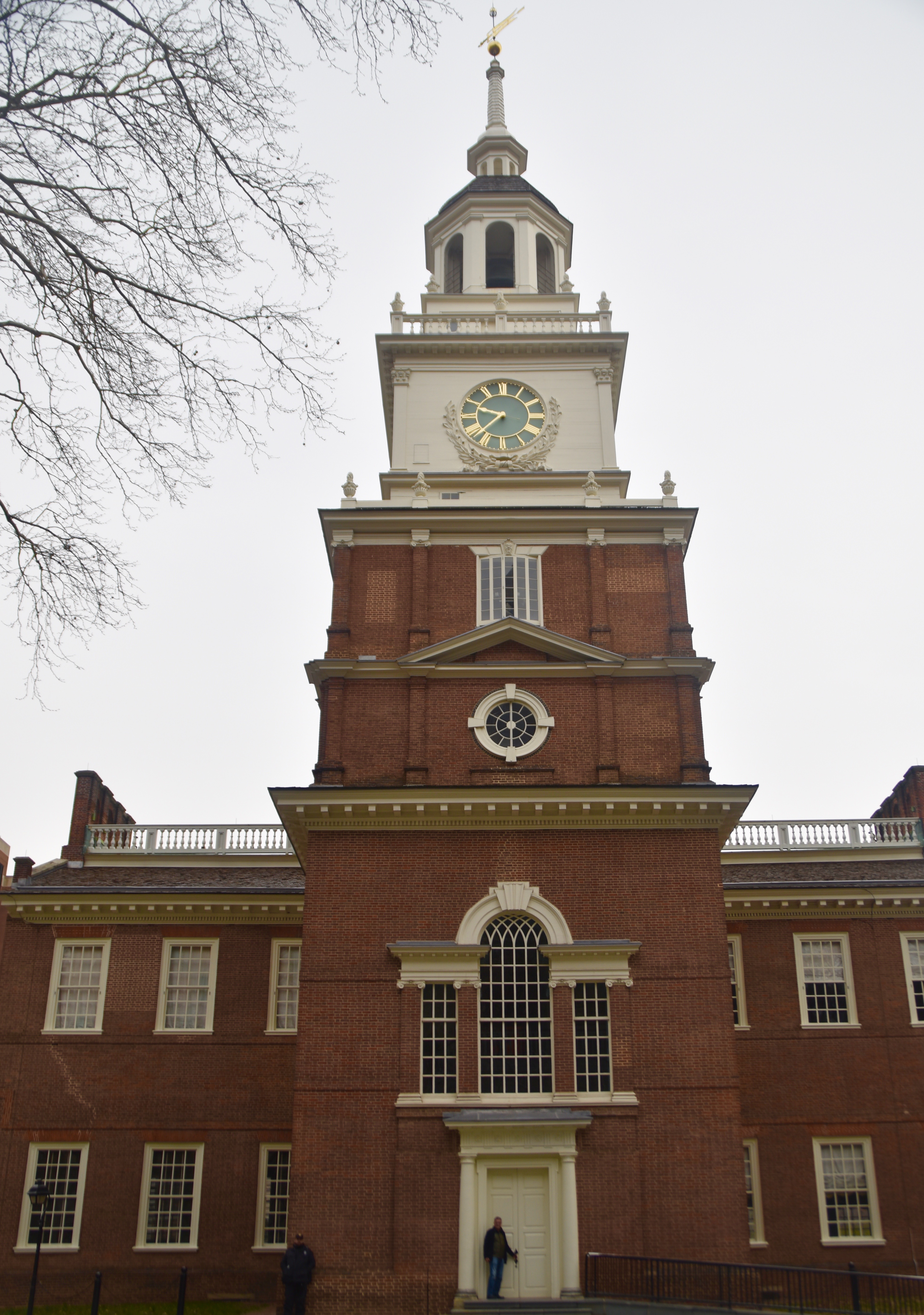
Back in line Alison poses with the tickets that will finally let us see inside the most historic building in the United States.
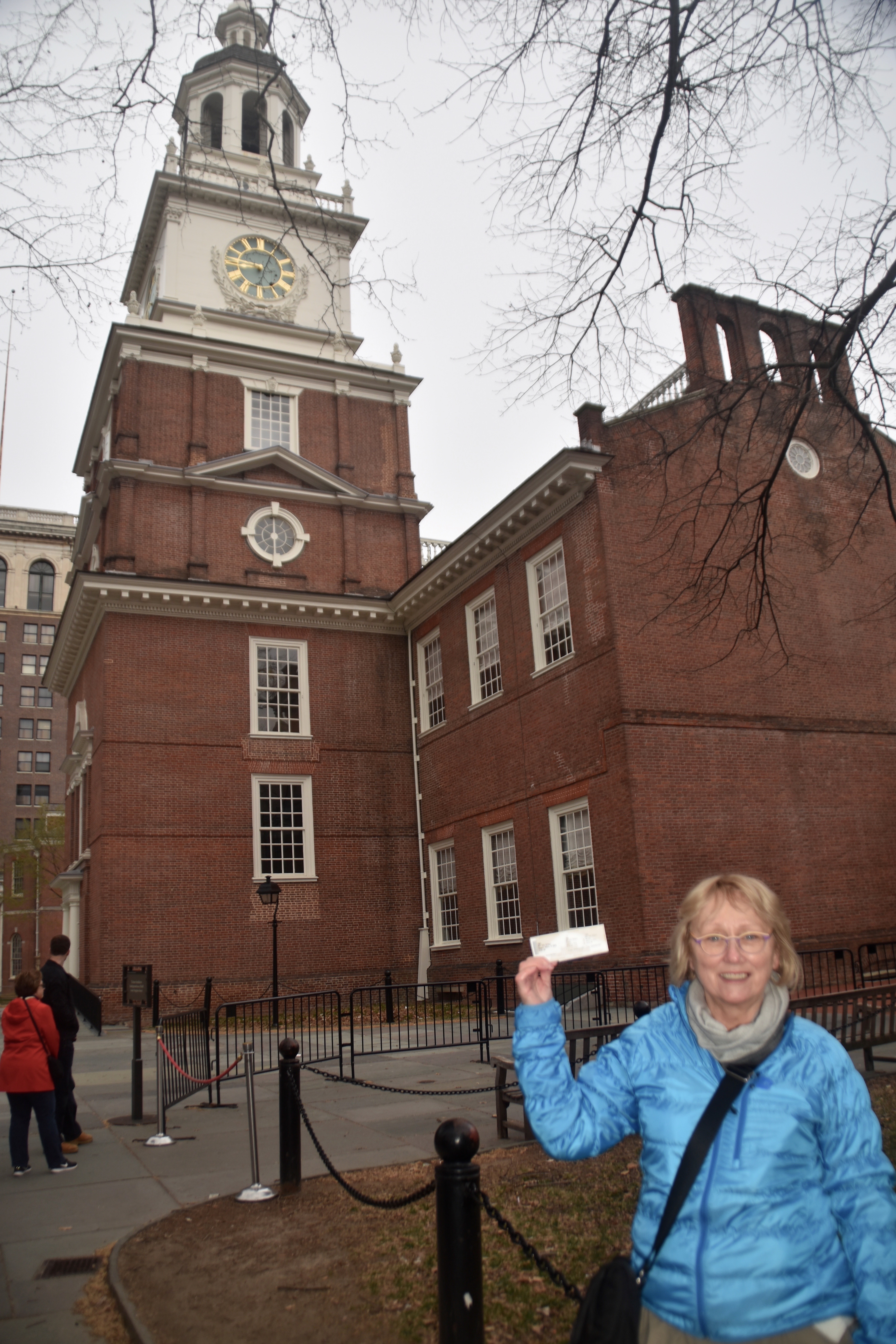
Just before entering I took this shot of the spire. The building is just made for photography from every angle.
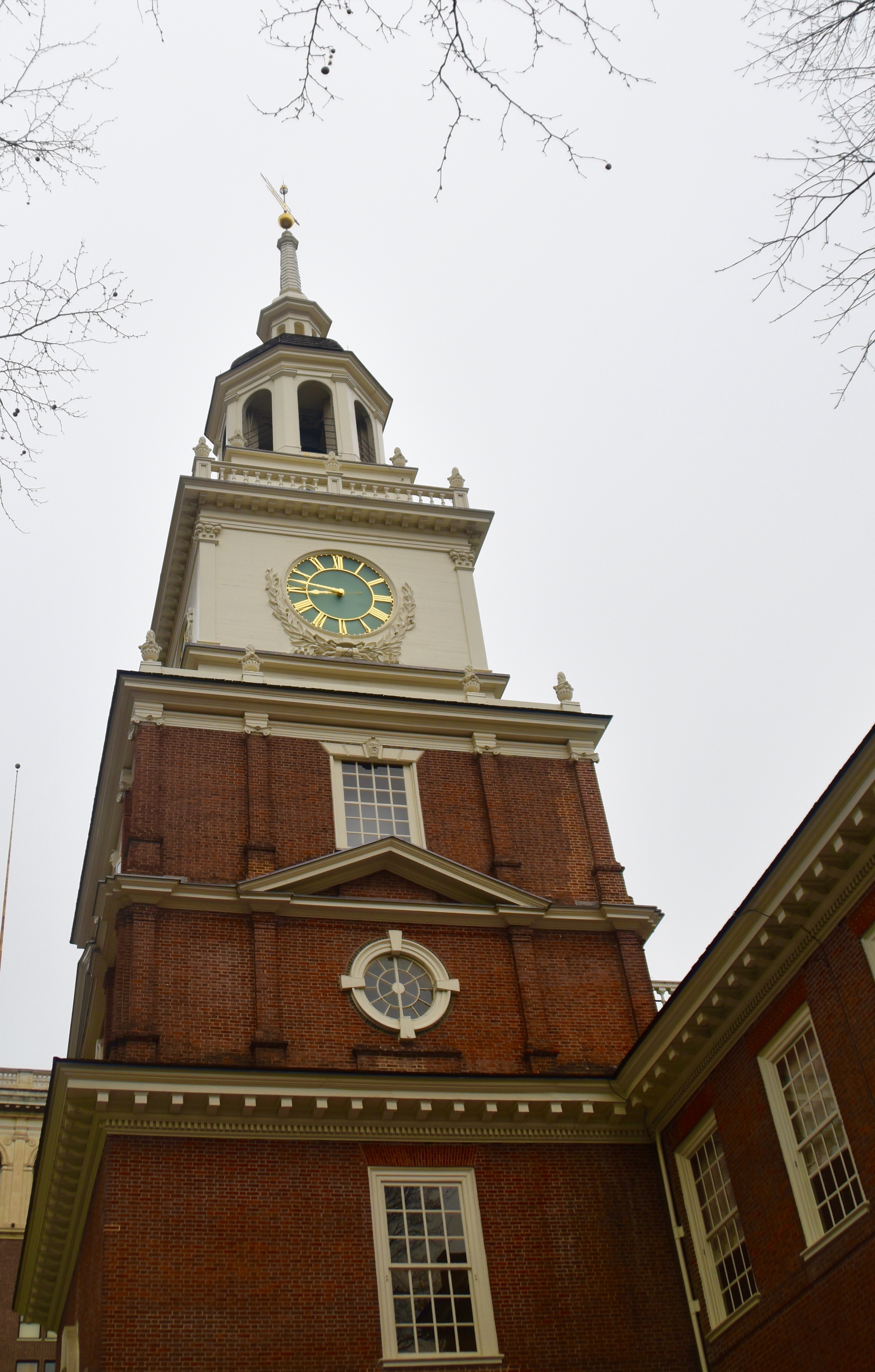
The guide is a Park Ranger who leads a group of about twenty into a small antechamber in the west wing where he gives us a quick run down on the events leading up to the American Revolution. He points out a number of famous people who were at the 2nd Continental Congress including George Washington, the tallest man standing and Ben Franklin, the oldest man seated.
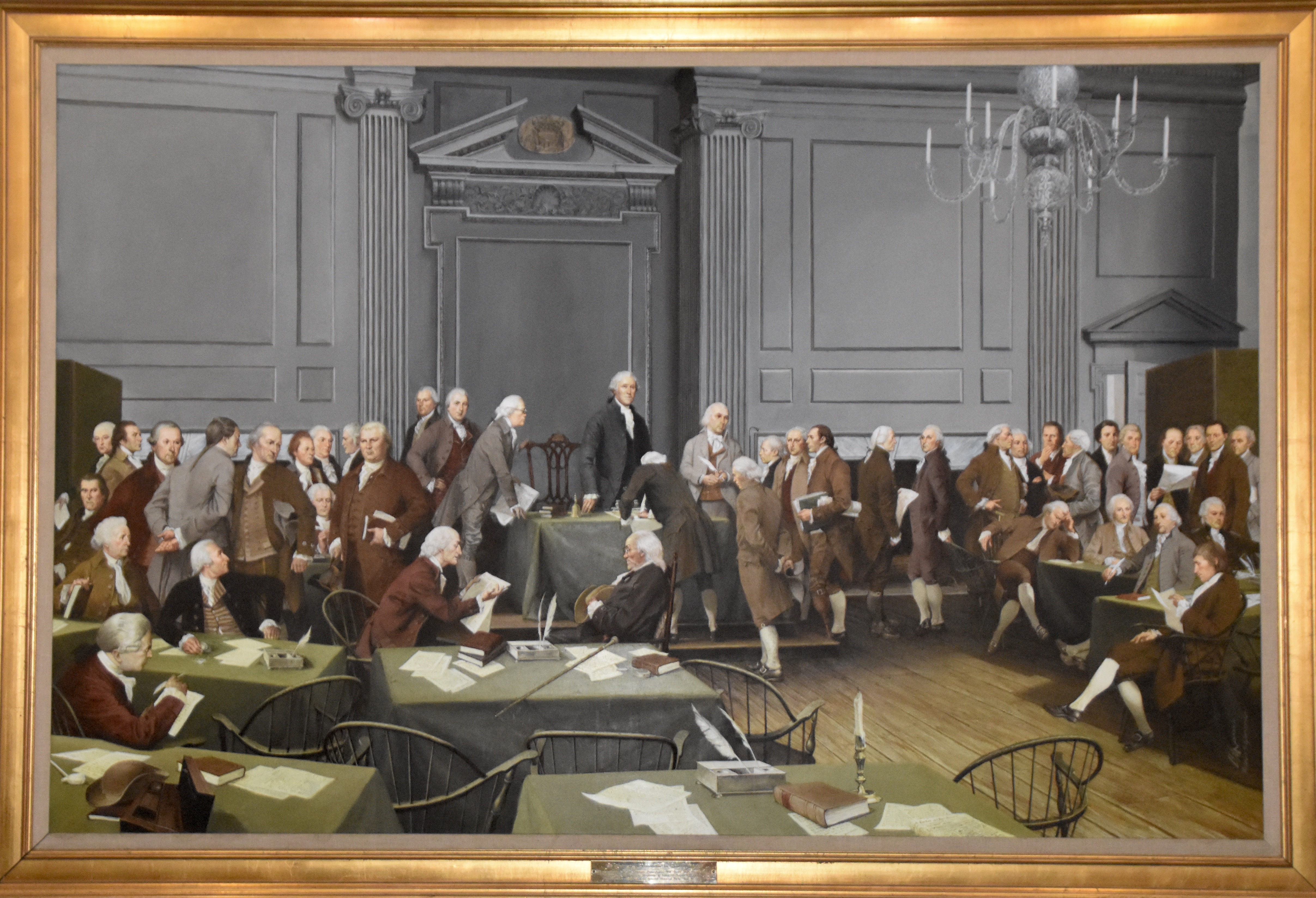
Independence Hall was actually the home of the Pennsylvania Assembly and the Pennsylvania Supreme Court when the men of the 2nd Continental Congress borrowed it for their deliberations starting in May, 1776. Our tour first takes us to the Supreme Court and not the more famous Assembly Room.
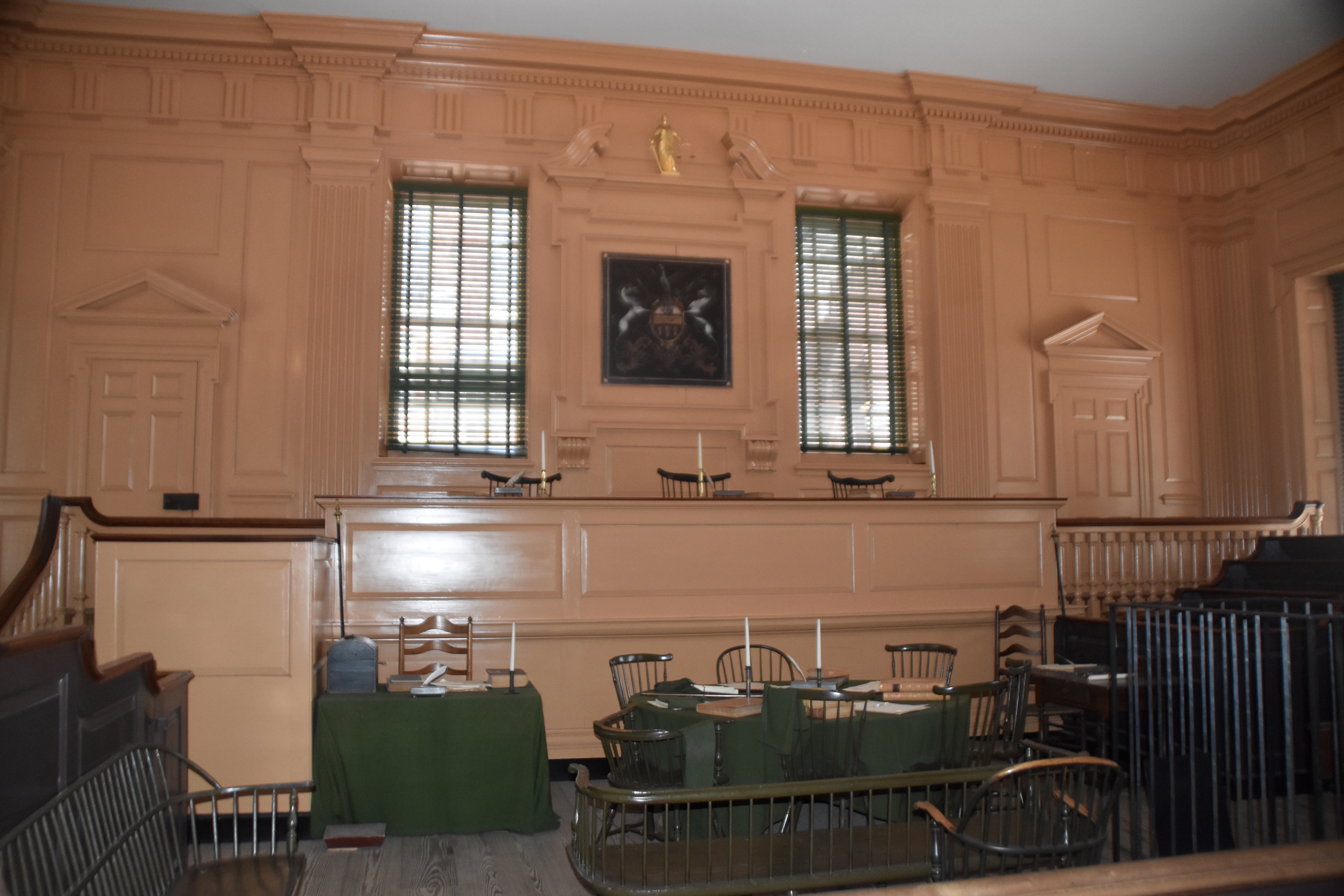
This is the view from the public gallery. The three judges would sit on the elevated bench, the lawyers and clerk below and as the ranger demonstrates, the accused in a cage. Don’t call it a prisoner’s box because, until the person is convicted, they are not a prisoner of the state, but merely an accused criminal.
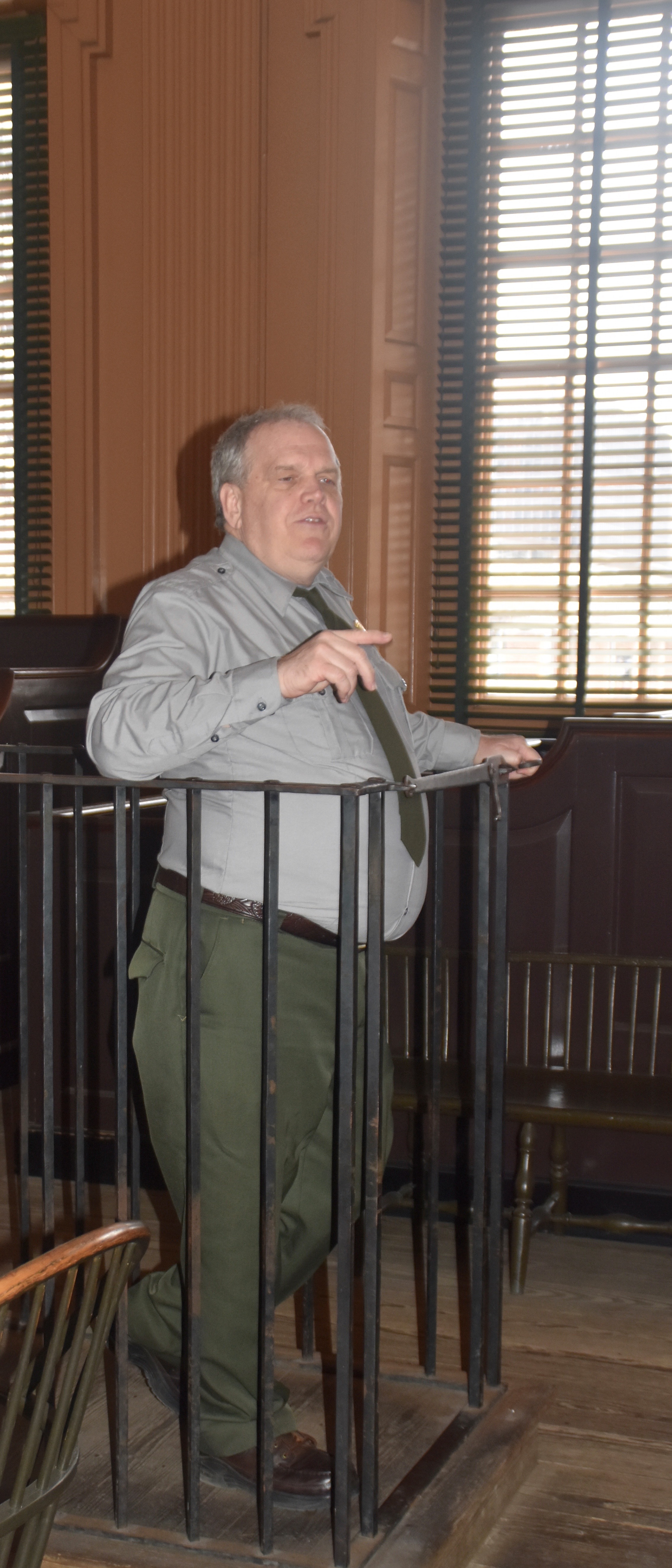
A detail of interest is the Pennsylvania coat-of-arms which was placed here after the Royal coat-of-arms was torn down. Interestingly, in the courtrooms I have appeared in in Canada, a version of that Royal coat-of-arms still sits over the judge’s head.
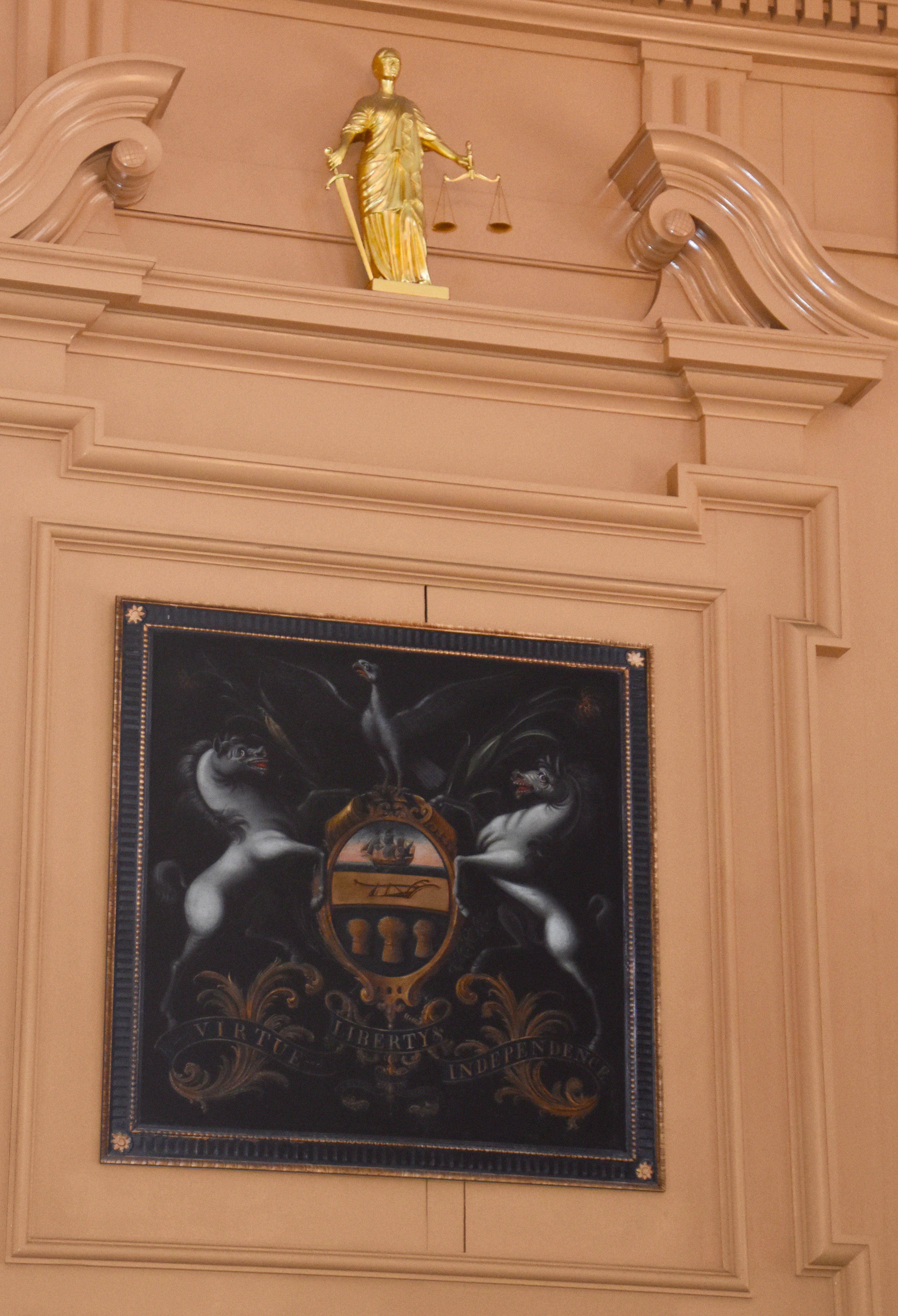
At last we move across the bottom story of Independence Hall to the Assembly Room where the Declaration of Independence was approved on July 4, 1776 and formally signed on August 2, 1776.
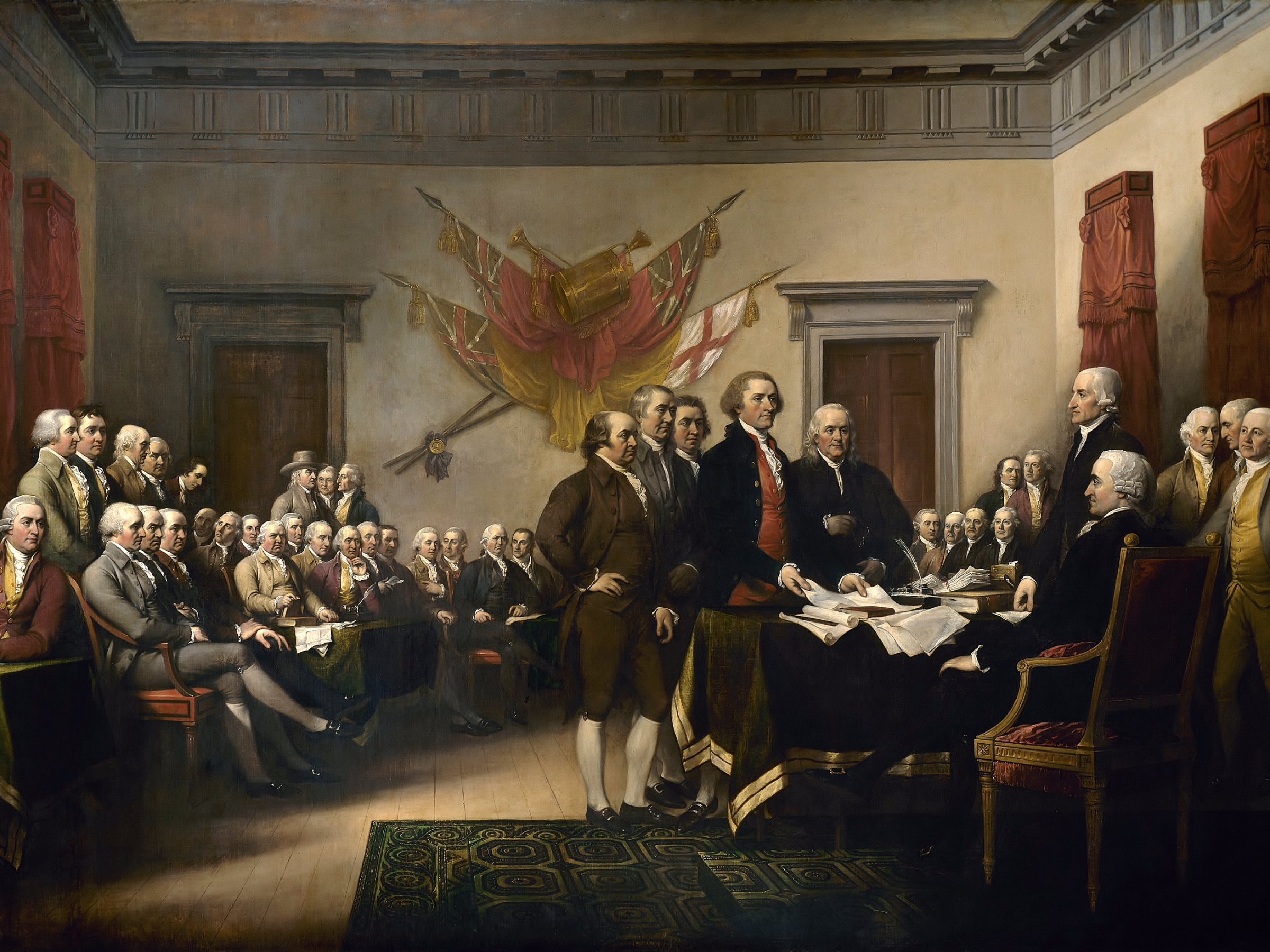
Many people mistakenly believe that the Declaration of Independence marked the beginning of the American Revolution, but that had been going on since April 19, 1775 when the ‘shot heard round the world’ was fired at Lexington, Massachusetts. In that time state militias had had a number of run ins with British soldiers, but it was not until the Declaration of Independence was signed by signatories from thirteen British colonies that an irreversible course of action began that was to change the way the people of the world thought about the way they were governed. And it all started in this room.
Besides passing the Declaration of Independence, the 2nd Continental Congress did a few other important things like appointing George Washington to create and lead a unified Continental Army, authorizing the printing of money to pay for the war and setting up a method of negotiating with foreign governments, particularly France.
But that’s not all that happened in this room. Eleven years later, after the war was won and the Treaty of Paris signed in 1783, delegates from twelve of the former colonies met here again from May 25 to September 17, 1787 in what is today called the Constitutional Convention. The Assembly Room has been preserved exactly as it would have looked during those days of hot weather and hotter tempers that ultimately lead to the adoption of the over arching document that has governed the United States ever since and been copied by endless other countries.
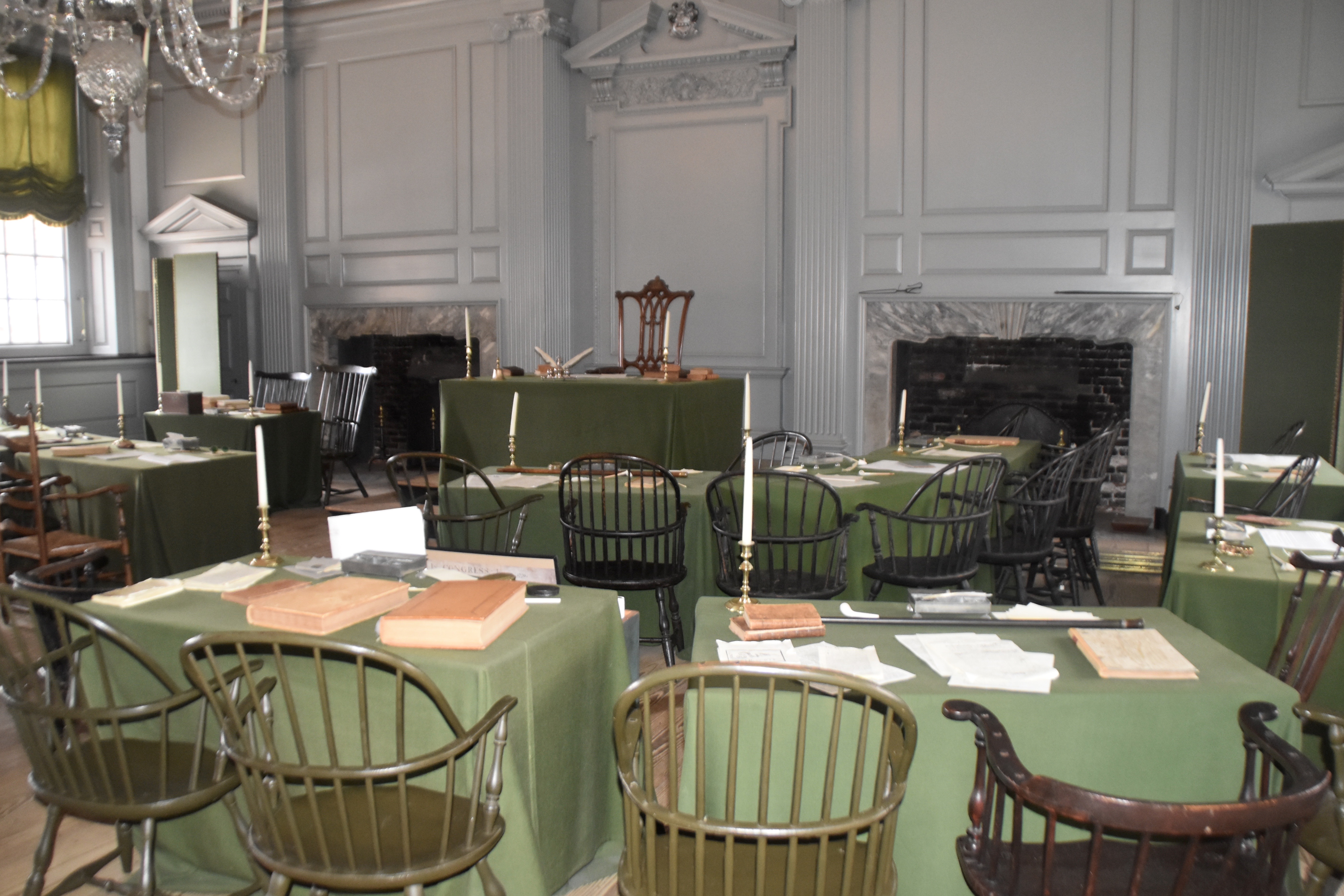
The years immediately following the Treaty of Paris had not been going well for the former colonies that were not yet one nation. There was a real possibility that the now free independent states would devolve into a civil war in much the same way as happened repeatedly in Mexico, Central America and South America countries after they gained their independence. So why didn’t that happen? Largely because of the efforts of one man, George Washington, who was called back from Mount Vernon to preside over the proceedings that eventually led to the creation and signing of one document that would create the United States of America.
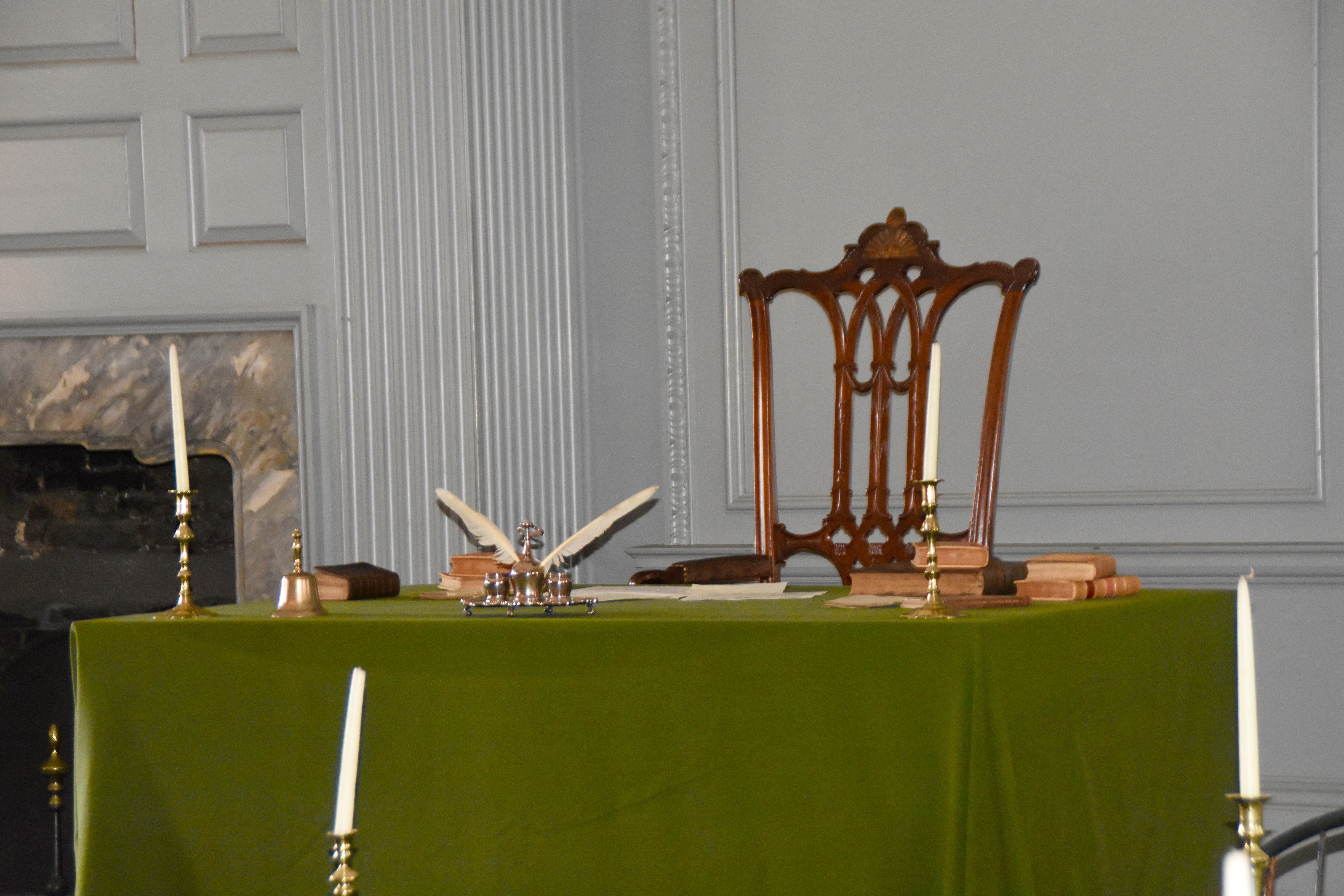
That’s Washington’s chair with the famous half-sun decoration at the top that led people to speculate whether it was rising or falling on the American nation’s fortunes.
This is the delegation from Virginia’s table and chairs.
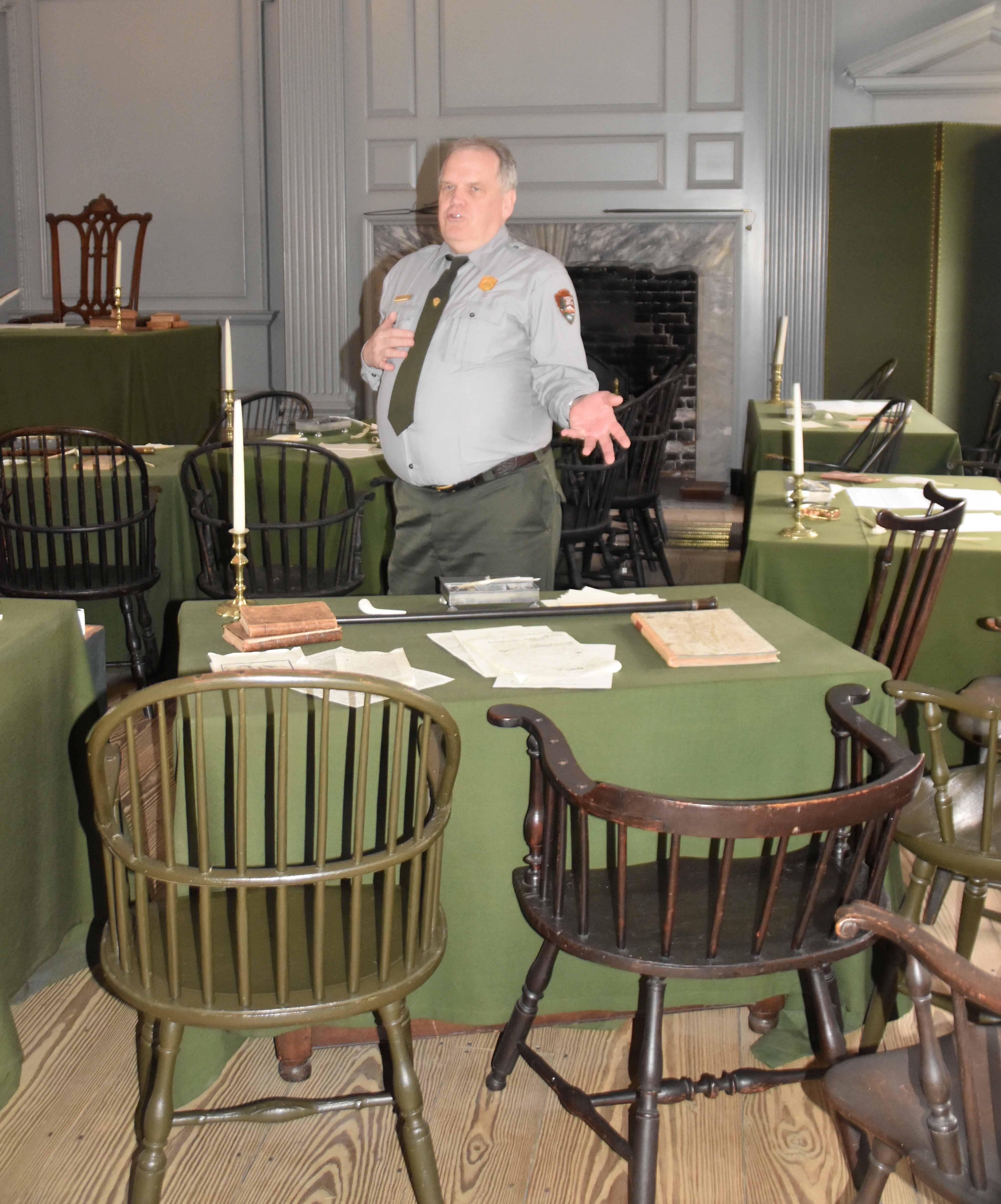
It doesn’t matter where you come from, this room has such a palpable sense of history that you are bound to be awed by just being in it. Certainly that’s the way Alison and I felt. You can close your eyes and easily imagine Washington, Franklin or Madison seated only a few feet away.
Everything about Independence Hall more than exceeded our expectations, but there was much more to see in Independence National Historic Park.
Congress Hall
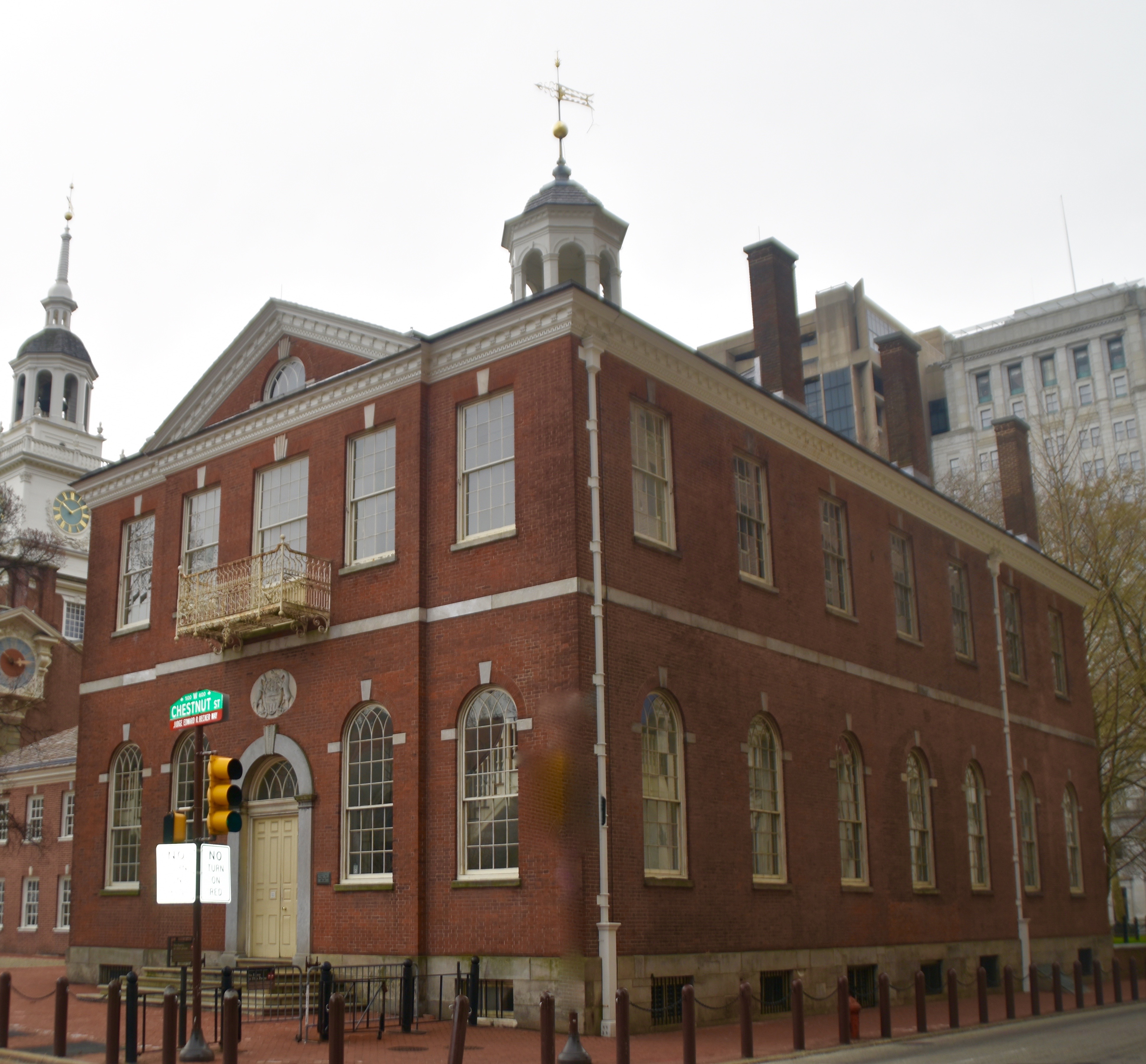
In truth, I was not even aware of the existence of Congress Hall let alone the decisive events that occurred there until my visit to Independence National Historic Park. I had just assumed that everything important happened in Independence Hall. This building, which sits on the corner of Chestnut and 6th Street is only about fifty feet away from Independence Hall and was originally the Philadelphia County Courthouse. It is part of the National Park and can only be entered after gaining entrance to the park. Here’s the tricky part – the guided tour of Independence Hall does not include Congress Hall and you must join a separate tour by lining up at the entrance where a park ranger will tell you when the next tour starts. I say tricky part because at least half the people on the Independence Hall tour didn’t seem to know this and missed visiting Congress Hall altogether. That’s a shame because the number of firsts that happened in this building is amazing. Here are the most important ones.
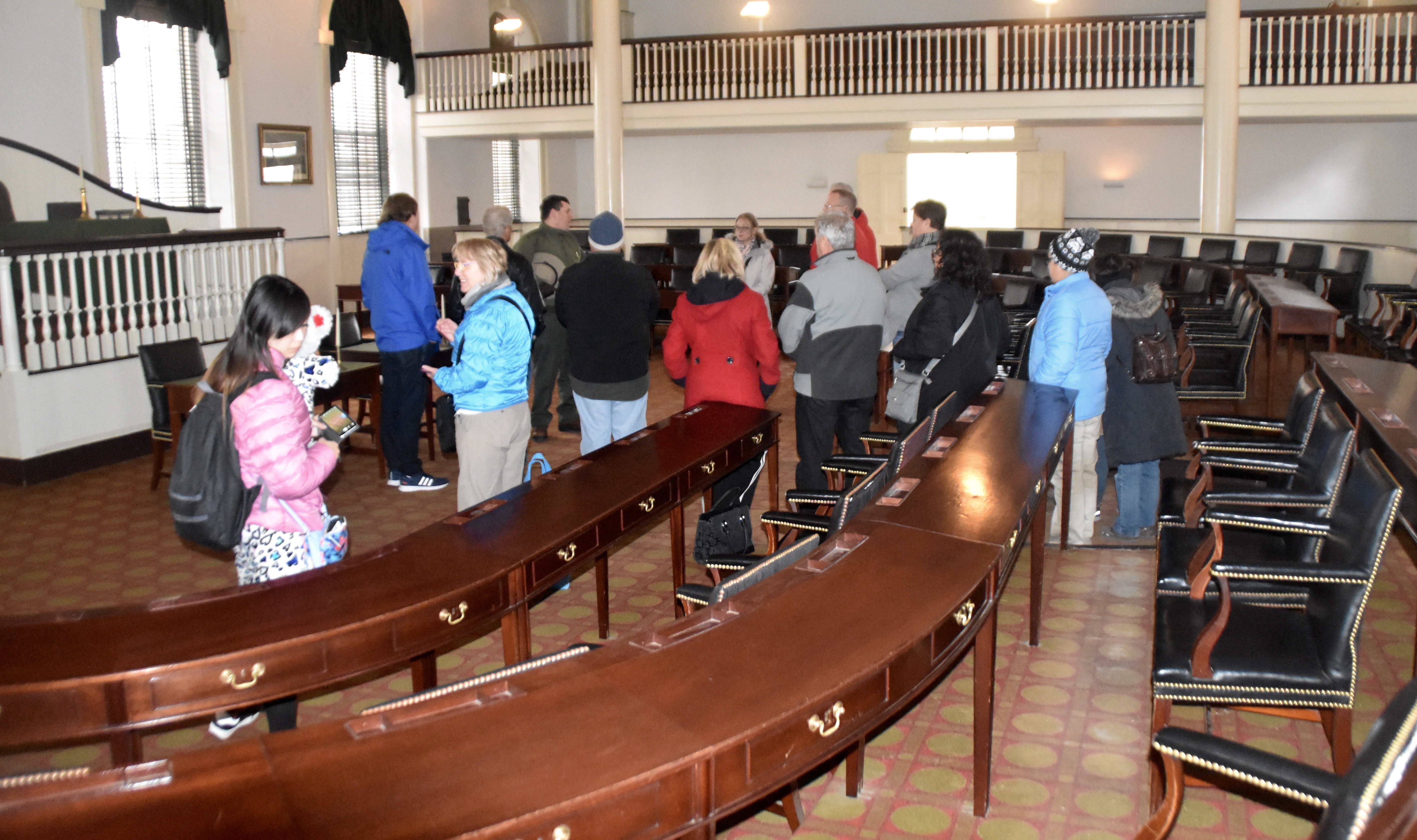
To start with it was the seat of the U.S. Congress from 1790 to 1800 when Philadelphia was the nation’s capitol. This is the House of Representatives. While it was only a decade, much that transformed the new democracy into what really became the inspiration for the rest of the world, was created in that time. I am referring to the first ten Constitutional Amendments that is collectively known as the Bill of Rights whereby the United States became the first country to guarantee individual liberties, rights and freedoms that could not be abrogated by the state.
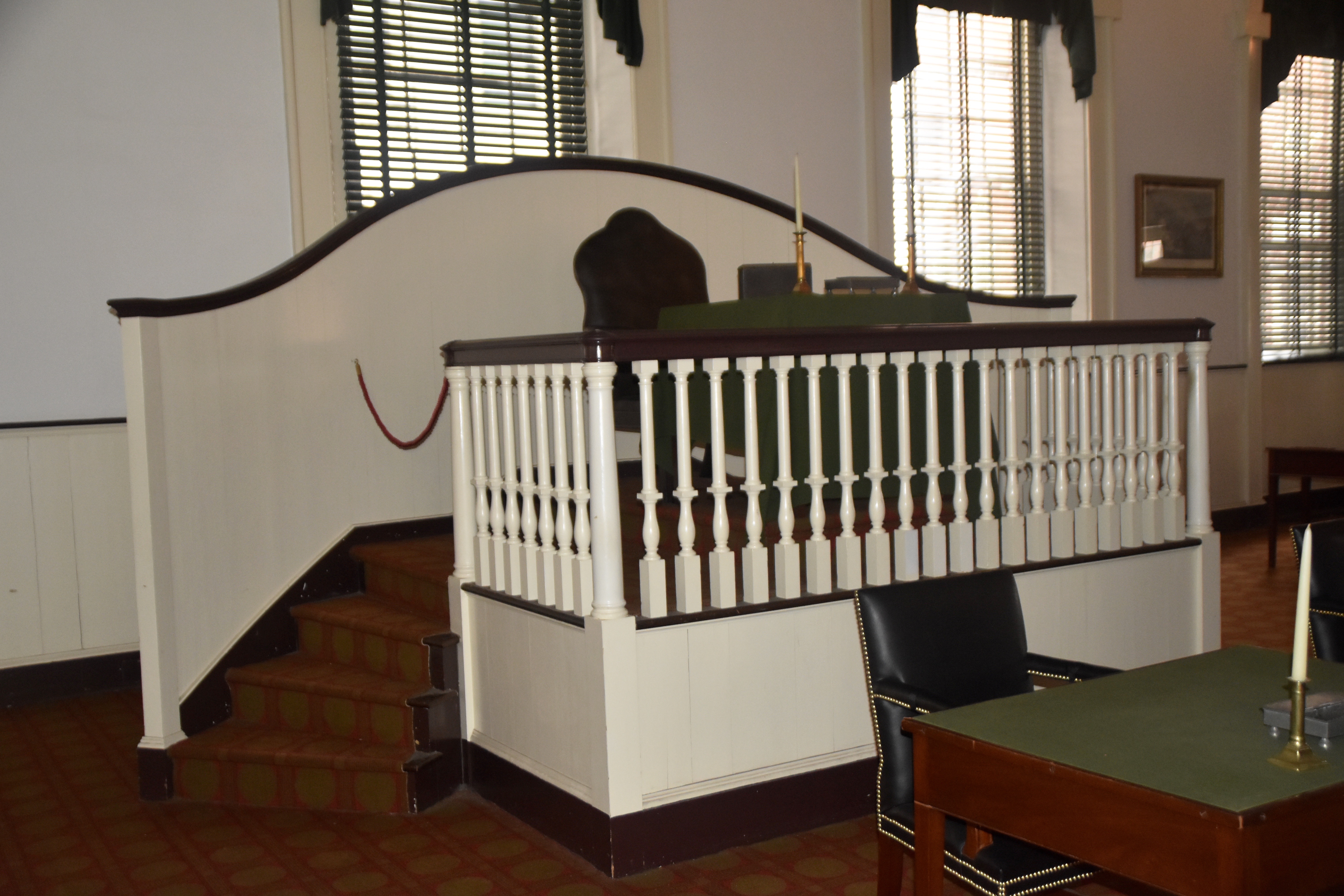
Other decisions taken in this building include establishment of the Federal Reserve Bank, the U.S. Mint and the U.S. Navy. Both George Washington (for a second term) and John Adams were inaugurated in this room. Adams’ inauguration began the tradition of a peaceful transfer of power during a time when changes in government were usually accomplished on the battlefield and not by the ballot box.
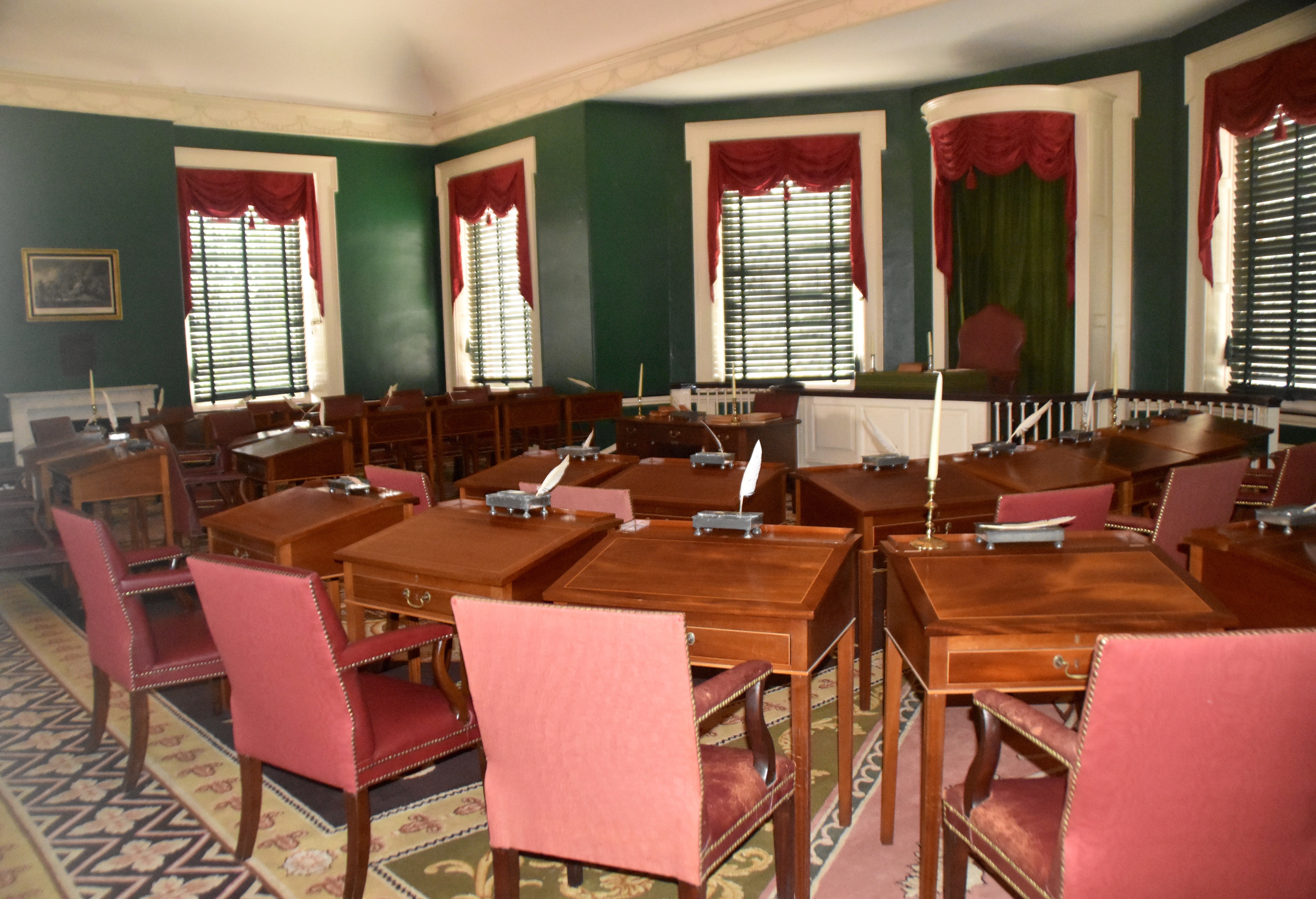
Upstairs is the more regal Senate house with much fewer members. From 1790 to 1796 it grew by six members with the admission of Vermont (1791), Kentucky (1792) and Tennessee (1796).
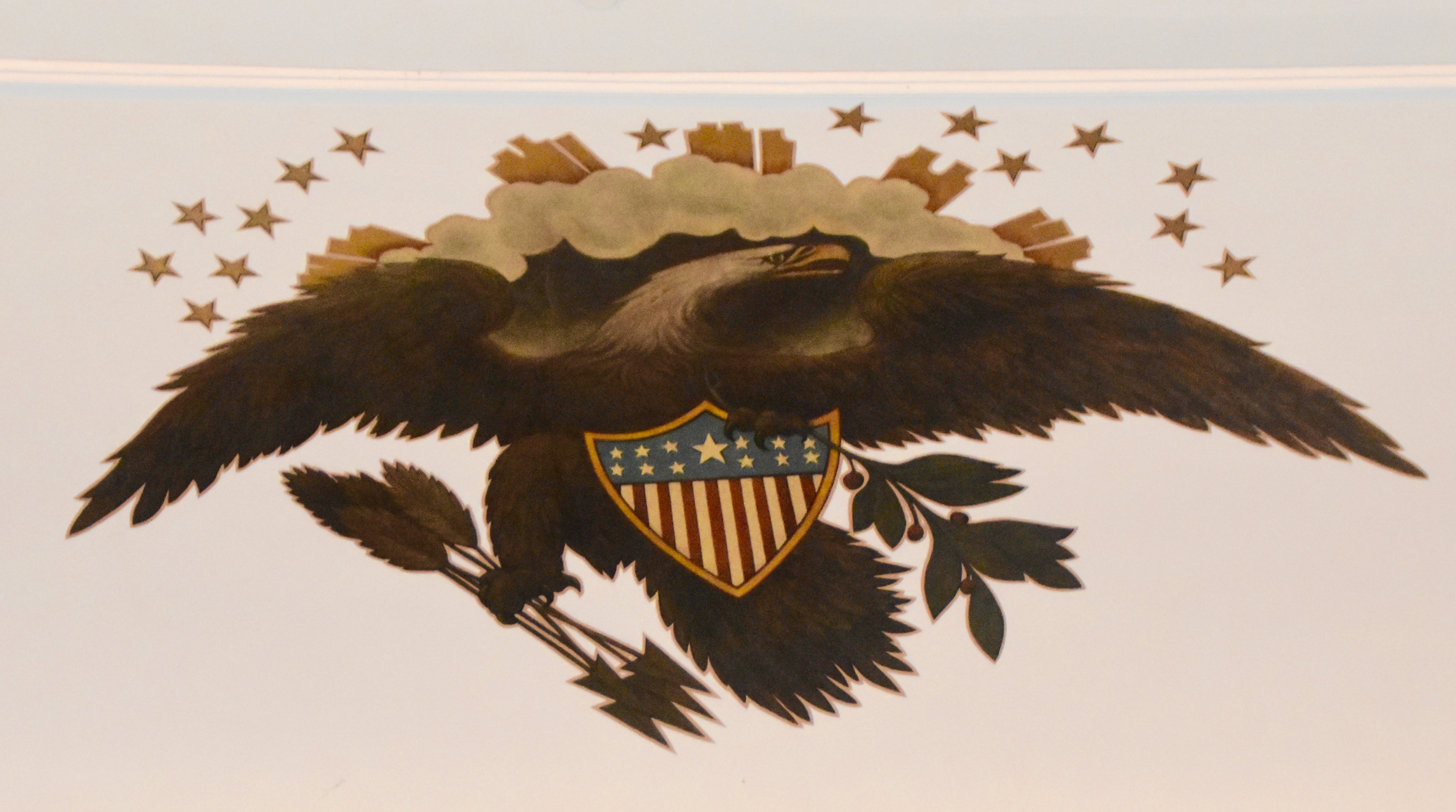
Unlike Independence Hall, a visitor is allowed to roam freely for about 10 minutes after the tour ends. This is one of the Senate Committee rooms. I wonder if the committees then were as divided along Whig/Federalist lines as the Republicans and Democrats are today. They should take note – the Whigs and the Federalist parties are remnants of the past, and they could be too.
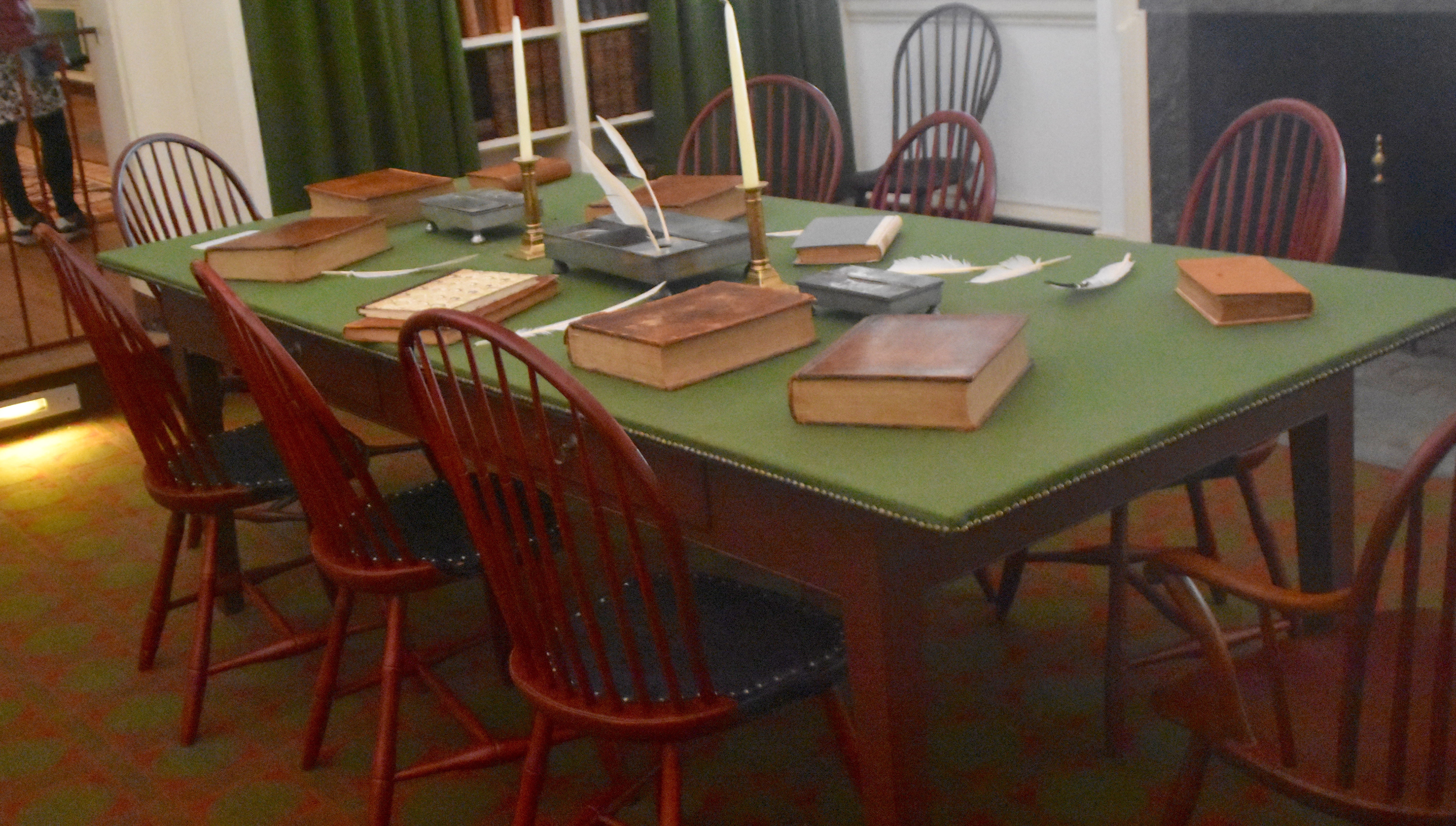
The one thing I was truly surprised to find in Congress Hall were these two life size portraits.
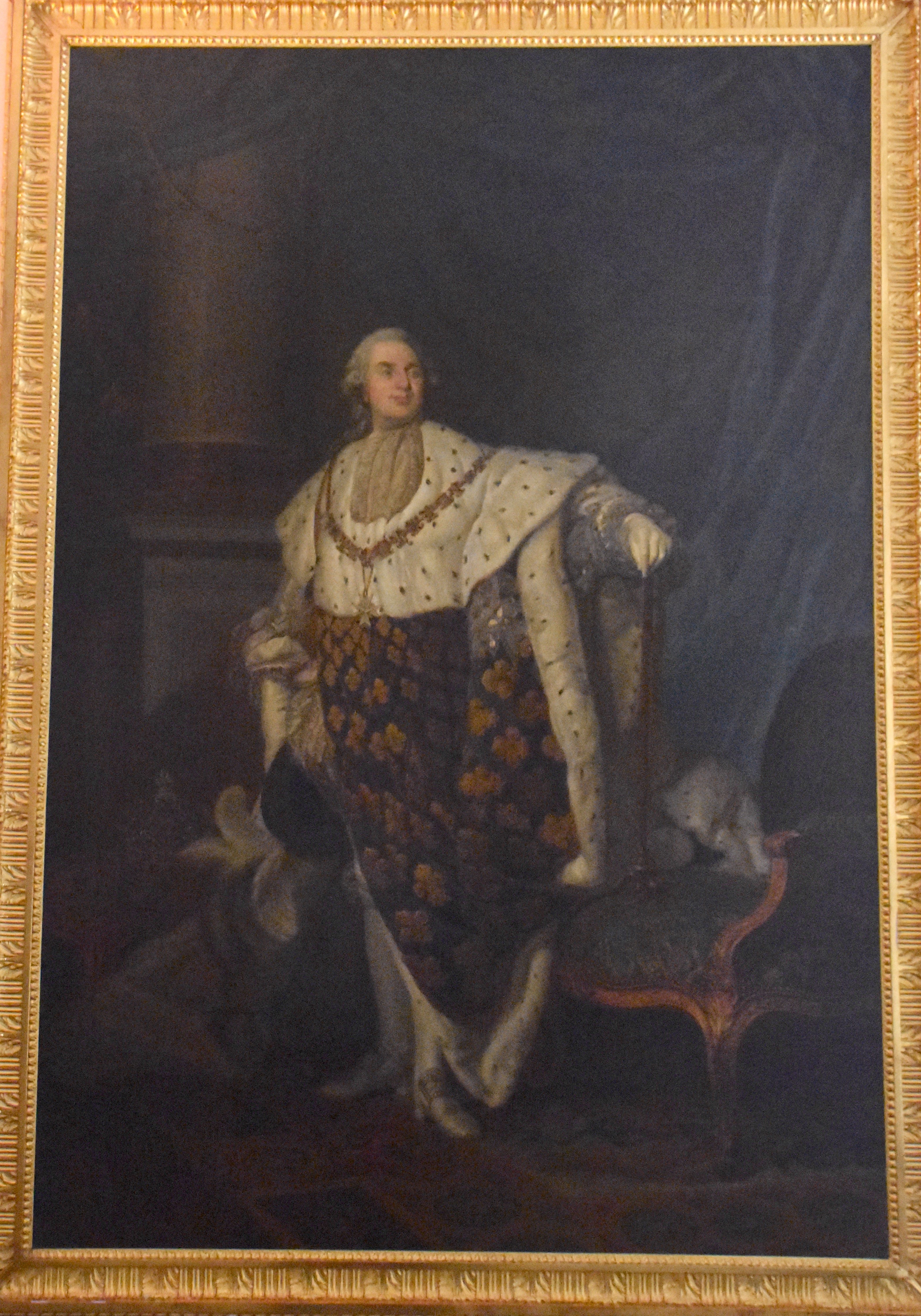
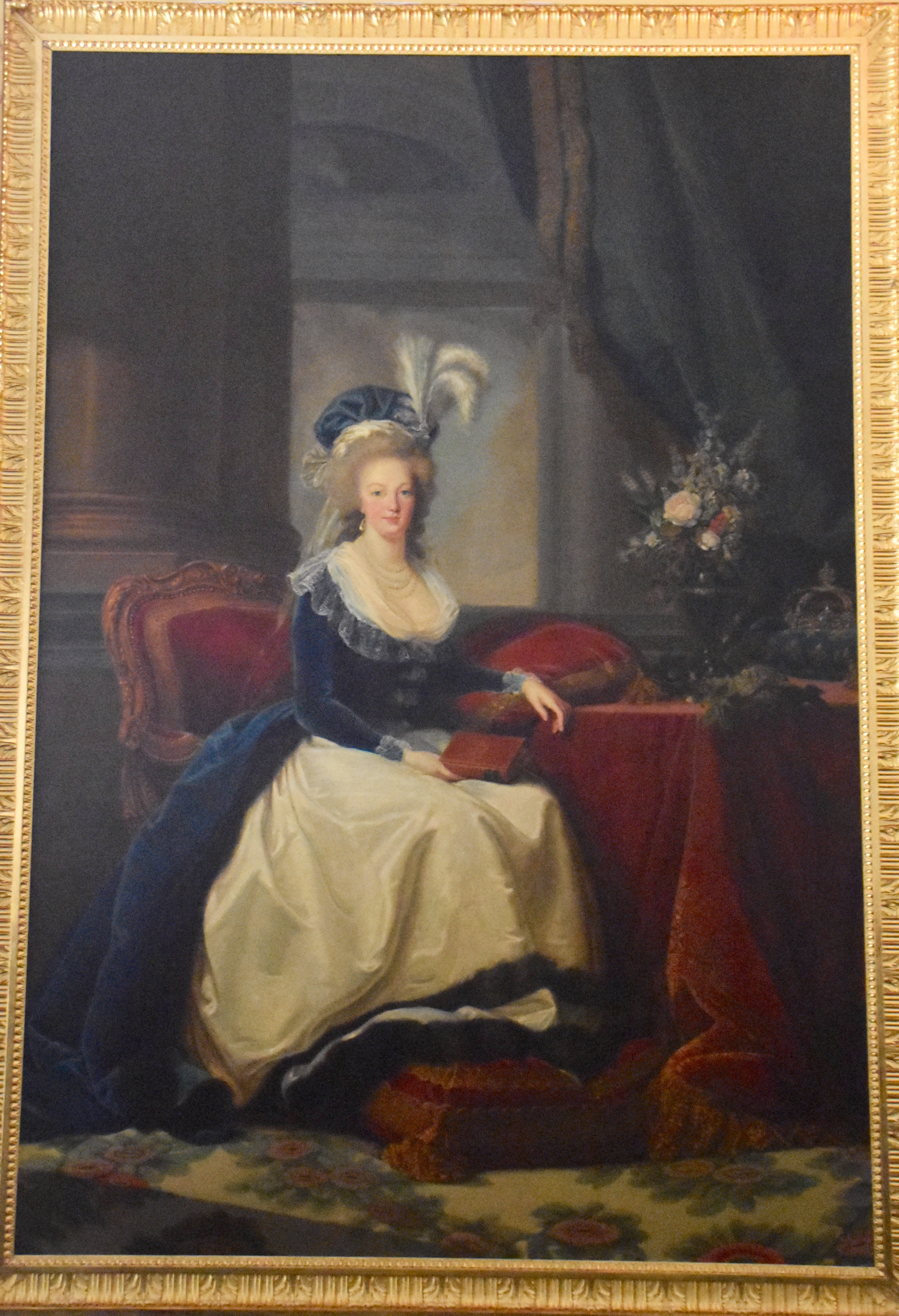
Yes, that’s King Louis XVI of France and his wife Marie Antionette of “Let them eat cake” infamy. These were gifts from them in remembrance of the help that France gave to the Americans, without which the rebellion could never have succeeded – more about that in an upcoming post about the siege of Yorktown.
Here’s the incredible irony. The Americans were rebelling against what they perceived as the tyranny of the British King George III, but they accepted help from another monarch who was so despised by his own people that he was beheaded along with his wife in 1793, while Congress was sitting in this very building. As William Shatner would ask, “How weird is that?”.
Like Independence Hall, Congress Hall is a place of great historical gravitas and you can sense while in the building. Whatever you do on a visit to Independence National Historic Park, don’t overlook a visit to Congress Hall.
The Liberty Bell
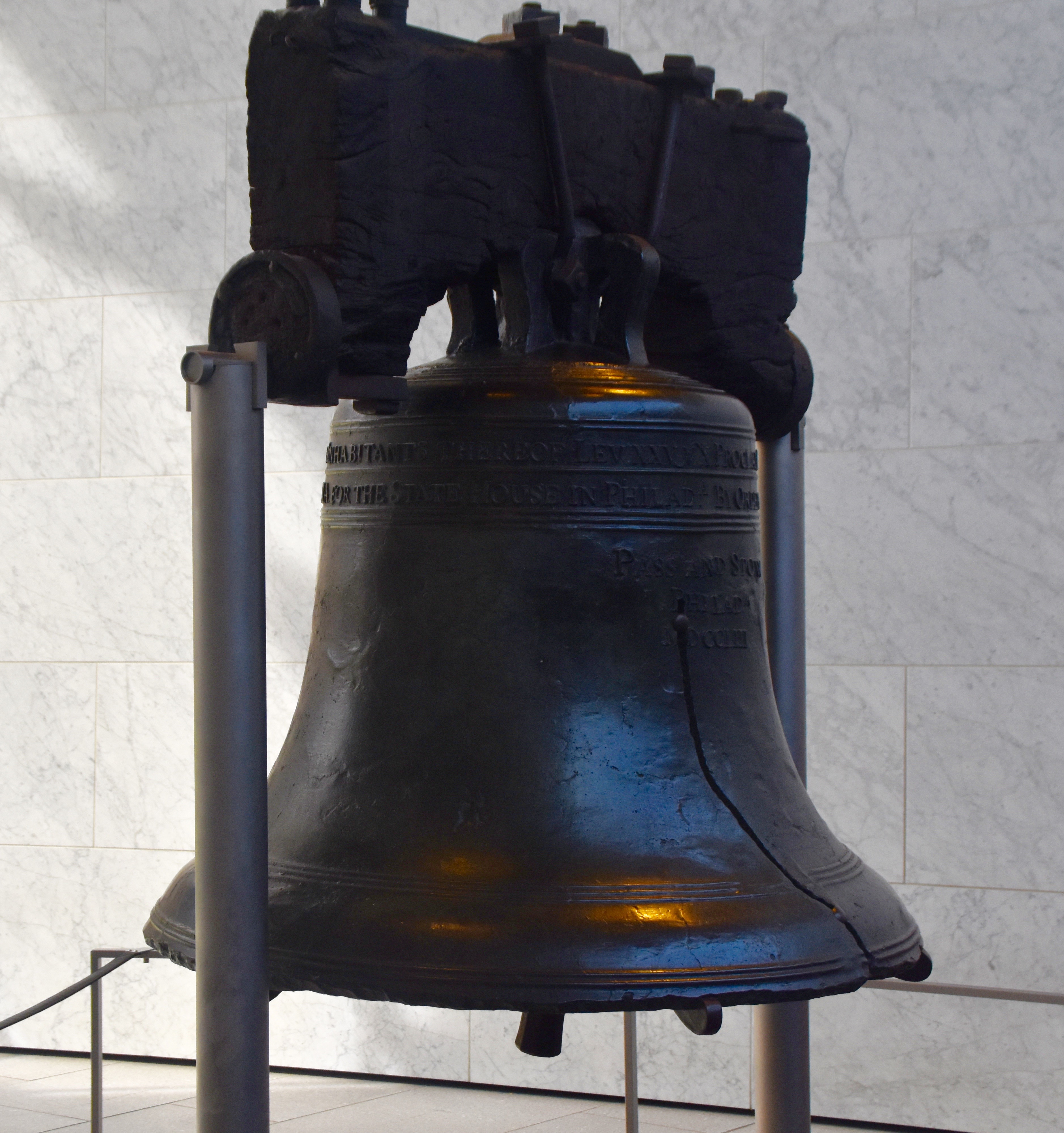
The Liberty Bell is one attraction in Independence National Historic Park that you don’t need to see on a guided tour. It has it’s own building between the Visitor Center and Independence Hall and all you have to do is walk in and listen to the Park Ranger on site tell you the history of the bell. It once rang proudly from the steeple of Independence Hall for almost 90 years until it developed a tiny crack which was made worse by efforts to repair it. The large crack you see in the bell today was caused by that failed attempt and is not the original which is pointed out by the ranger.
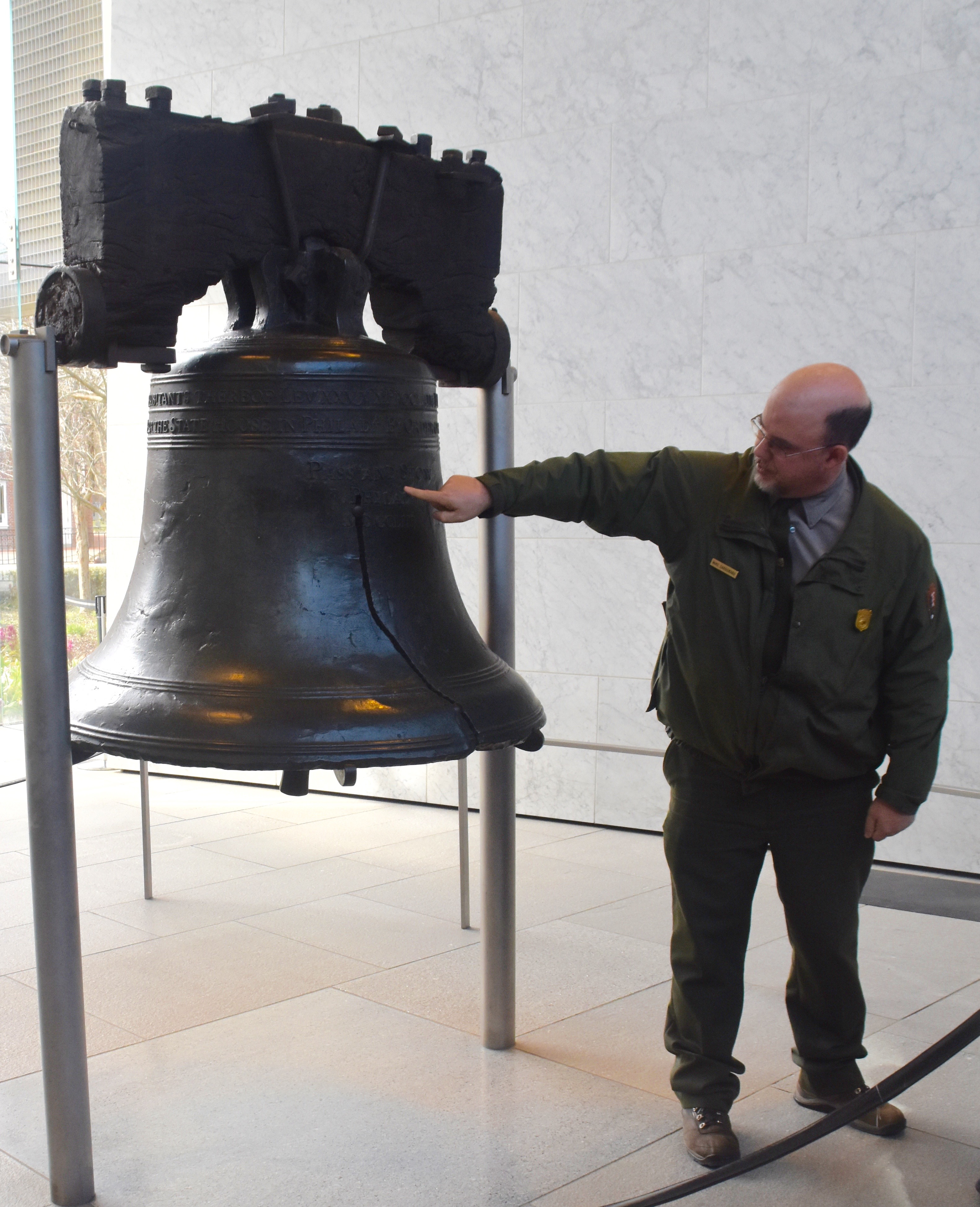
I began this post with a picture of George Washington and I’m going to end on the same note. This is George and me in front of Independence Hall.
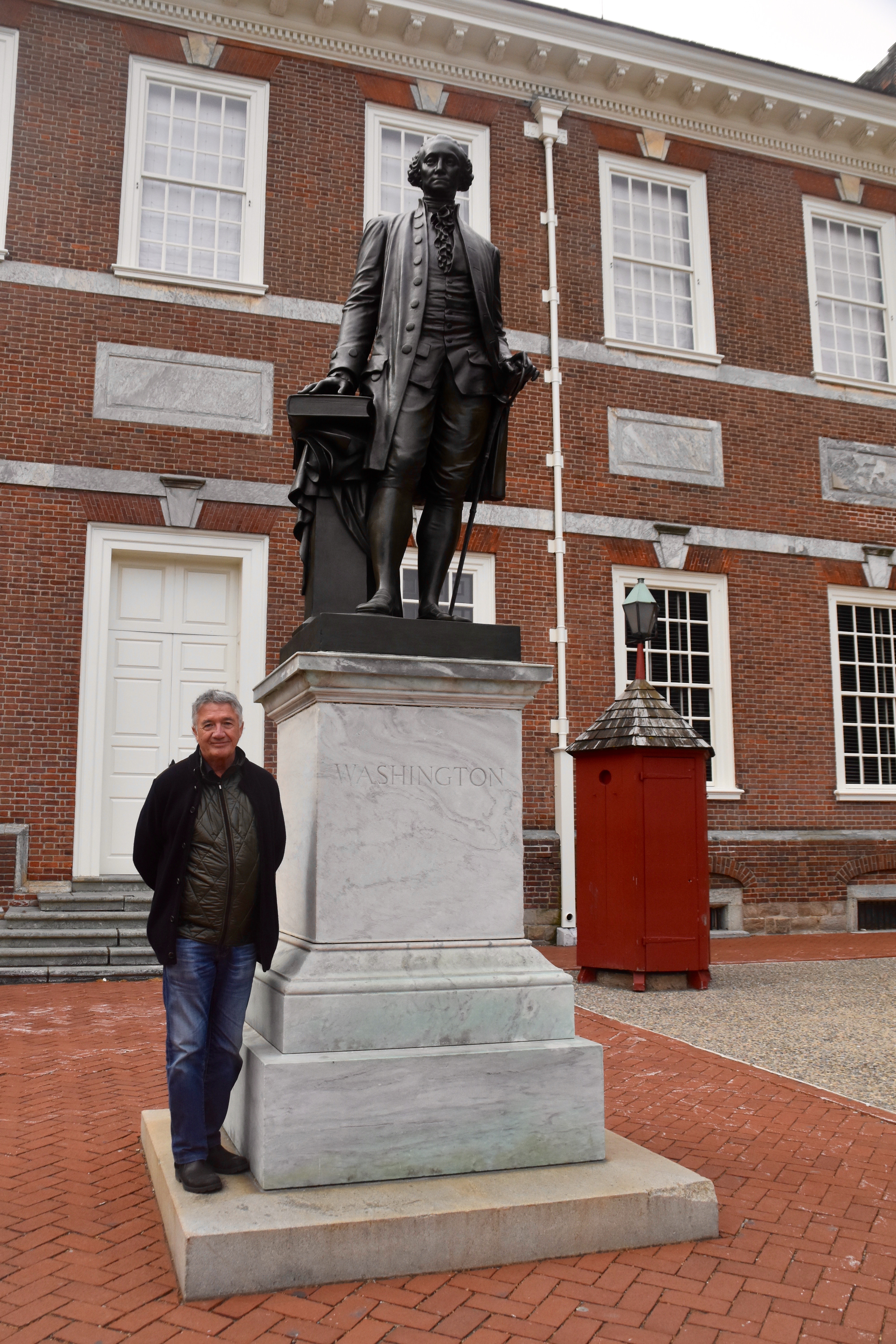
I hope this post has convinced readers of all nations that a visit to Independence National Historic Park is a must do for everyone who loves history and values freedom.
For more ideas of what to do in Philadelphia read this post.

